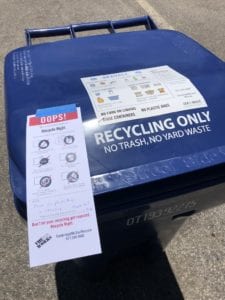Who is a member?
Our members are the local governments of Massachusetts and their elected and appointed leadership.

The city of Cambridge has used data analysis and public outreach to reduce recycling costs and improve its program.
By sifting through recycling bins and analyzing residents’ biggest recycling errors, the city of Cambridge was able to mount a targeted campaign to change recycling habits and reap substantial savings.
The detailed data analysis and outreach to 44,500 households that recycle curbside has reduced recycling contamination rates from 11% in 2018 to 4% in 2020, saving more than $100,000 last year, even as residents recycled more at home during the pandemic.
“It’s kind of a pleasant surprise that the contamination kept going down,” said Cambridge Recycling Director Mike Orr, “but I think it’s a testament to the residents really caring about the environment and really wanting to do the right thing, and it’s paying dividends.”
In 2018, China, which was accepting the bulk of U.S. recyclables, banned imports of certain solid waste and tightened restrictions on contamination rates. Orr said Cambridge faced financial penalties if it couldn’t drive the recycling contamination rate below 7%.
Cambridge’s recycling project reflects its data-driven approach to managing city operations. The city started by collecting data about what residents were putting in their bins.
First, the city’s recycling processor provided monthly data on contamination, tracked by truck routes and collection days. Then the city audited more than 1,000 bins to identify the most problematic items.
The biggest contaminants were plastic films and wrappers (found in 52% of the problematic bins), plastic-bagged recycling (21%), and paper towels, napkins and tissues (20%). Other contaminants included food and liquid, paper takeout containers and plates; clothing and textiles; cords and hoses; and wood, metal and electronic waste. Orr said multi-family buildings pose the biggest challenges, due to the number of recyclers involved.
Working with the Center for Government Excellence, known as GovEx, at Johns Hopkins University, the city’s Data Analytics and Open Data Program dove in. The city found that contamination spiked during typical moving times for renters, early fall and spring, according to Open Data Program Manager Josh Wolff. The program created a predictive algorithm, which uses data such as residential building size to predict the likelihood of recycling contamination, to help policymakers decide how to allocate outreach and enforcement resources.
Cambridge then initiated its Recycle Right campaign, monitoring and tagging bins with medium or high amounts of contamination. For buildings with major problems, the city sent postcards to each household.
The city created signs to explain recycling rules, posted advertisements at Bluebike stations and MBTA bus shelters, used sandwich boards, created flyers and new stickers for bins, and sent mailers about waste services and proper recycling. The city’s recycling collectors started rejecting more bins and leaving rejection stickers.
“It was trying to find all of those touchpoints that people would see in their regular day,” Orr said.
The $100,000-plus represents significant savings, Orr said, given that recycling processing might typically cost about $650,000 a year.
The recycling analysis represents just one of the city’s collaborations with GovEx, Wolff said. The data analysis work helps ensure transparency and accountability in city operations, improve service delivery and efficiency, and increase innovation, he said.
“Through data analysis, we can discover previously unknown trends and patterns that impact residents,” Wolff said.
Last year, the city received a What Works Cities Silver Certification, a Bloomberg Philanthropies initiative that recognizes well-managed, data-driven local governments.